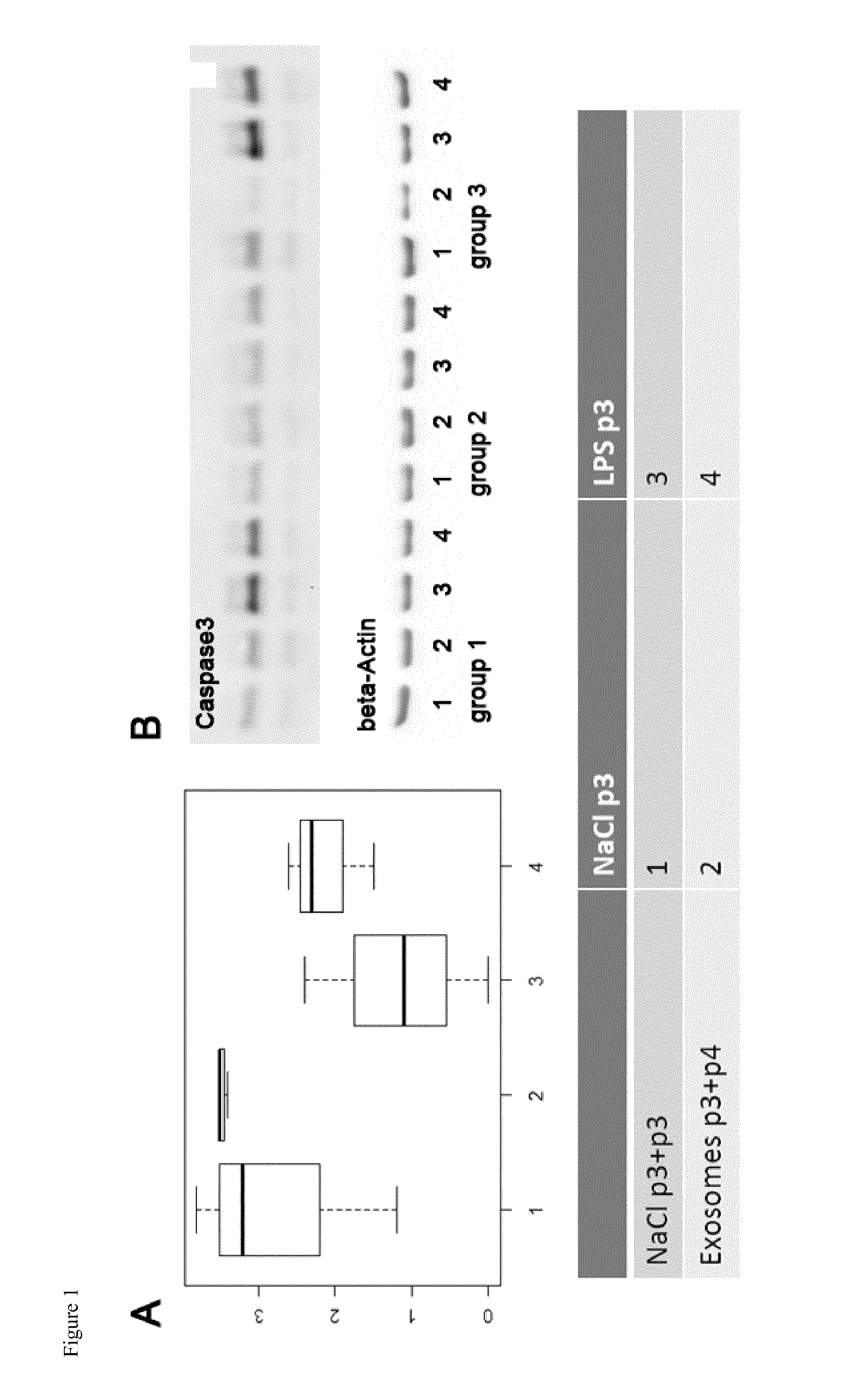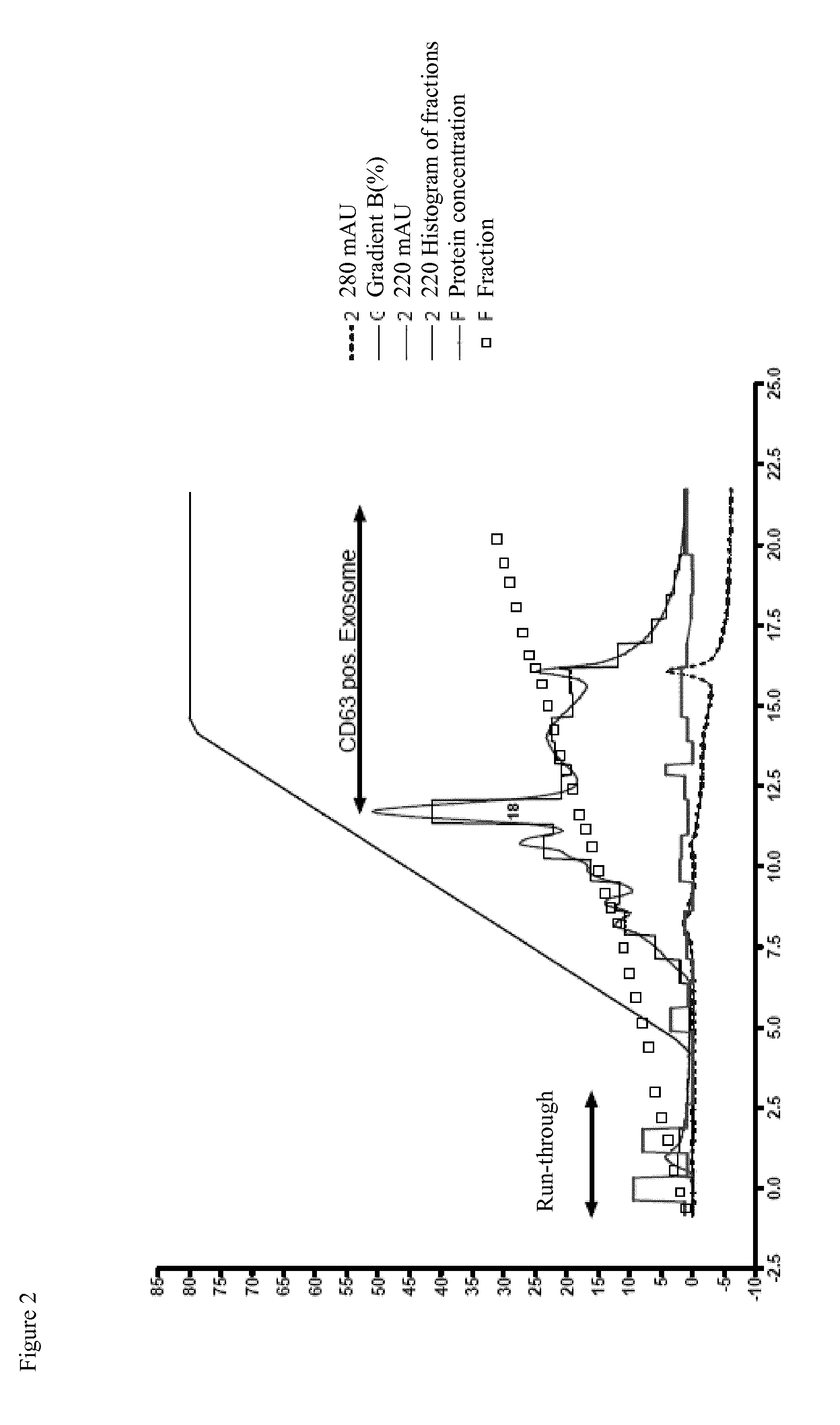Use of Preparations Comprising Exosomes Derived From Mesenchymal Stem Cells (MSCs) in the Prevention and Therapy of Inflammatory Conditions
a technology of mesenchymal stem cells and preparations, which is applied in the direction of snake antigen ingredients, biochemistry apparatus and processes, pharmaceutical non-active ingredients, etc., can solve the problems of rare cells engrafting and differentiation, unimodal approach, and complex pathophysiological biological structur
- Summary
- Abstract
- Description
- Claims
- Application Information
AI Technical Summary
Benefits of technology
Problems solved by technology
Method used
Image
Examples
example i
Distinct MSC Exosome Preparations Contain Different Cytokine Compositions
[0061]The exosome-enriched fractions derived from the four MSC preparations were analyzed for their content of anti- and pro-inflammatory as well as apoptosis-inducing molecules (Table 1). Apart from the pro-inflammatory cytokines IFN-γ and IL-8, the exosome preparations contained high quantities of the anti-inflammatory molecules IL-10, TGF-β1 and HLA-G. Neither the pro-inflammatory cytokines IL-1β, IL-2, IL-6, IL-17a, IL-21 and TNF-α, the anti-inflammatory cytokines IL-1β Ra and IL13, nor the apoptosis-inducing molecule sFasL were detected in any of the exosome preparations (Table 1).
[0062]Especially the MSC1 exosome preparation (MSC1 Exo) contained elevated TGF-β levels, which surpassed TGF-β plasma levels of healthy donors by more than the factor 10. In addition MSC1 Exo differed from the others preparations with regard to the anti-inflammatory cytokine IL-10 and the pro-inflammatory cytokine IFN-γ. The rat...
example ii
[0074]As an undesired side effect of allogeneic bone marrow transplantation, some patients with malignant hematological diseases develop GvHD, i.e. a condition, in which the new immune system recognizes the patient's tissue as ‘foreign’ and attacks it. Usually, transplanted patients receive immunosuppressant treatments. Patients refractory to such treatments have a poor prognosis, while transplanted MSCs might improve the clinical response (Gotherstrom et al., 2004; Le Blanc et al., 2004). Meanwhile it is assumed that the immunomodulatory activities of MSCs result from secreted soluble factors rather than direct cellular interactions between engrafted MSCs and the patient's immune cells (Baron and Storb, 2012). The inventors hypothesized that the effectors are MSC-derived exosomes.
[0075]Given the history of a female patient with myelodysplastic syndrome that had received allogeneic bone marrow transplantation, the patient developed a refractory, severe GvHD. After written consent an...
example iii
Comparison of Immune Modulatory Activities of Exosome-Enriched Fractions Obtained from Different MSC Preparations
[0111]The inventors compared the immune-modulative activity of exosome-enriched fractions obtained from 10 independent MSC preparations within T cell assays. To measure the exosomes' impact on the proliferation of phytohemagglutinin (PHA) stimulated T cells, exosomes equivalents of 800.000 MSCs (corresponds to 0.02 Units of the exosome enriched fractions) were added into each reaction. Apart of the control, approx. 200.000 CFSE stained, living PB-MNCs of given donors were stimulated with the lectin PHA (final concentration: 200 ng / ml) for 5 days. Thereafter, cells were stained with anti-CD3 antibodies and analyzed by flow cytometry in two independent experiments. As highlighted in FIG. 6, all nonstimulated T cells retained their CFSE label. In contrast, a large proportion of PHA stimulated T cells showed reduced CFSE intensities indicating that these cells had been activa...
PUM
| Property | Measurement | Unit |
|---|---|---|
| Size | aaaaa | aaaaa |
| Density | aaaaa | aaaaa |
| Biological properties | aaaaa | aaaaa |
Abstract
Description
Claims
Application Information
 Login to View More
Login to View More - R&D
- Intellectual Property
- Life Sciences
- Materials
- Tech Scout
- Unparalleled Data Quality
- Higher Quality Content
- 60% Fewer Hallucinations
Browse by: Latest US Patents, China's latest patents, Technical Efficacy Thesaurus, Application Domain, Technology Topic, Popular Technical Reports.
© 2025 PatSnap. All rights reserved.Legal|Privacy policy|Modern Slavery Act Transparency Statement|Sitemap|About US| Contact US: help@patsnap.com



